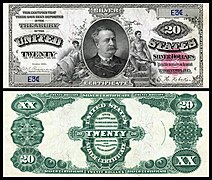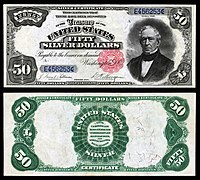|
Featured picture tools: |
These featured pictures, as scheduled below, appeared as the picture of the day (POTD) on the English Wikipedia's Main Page in June 2022. Individual sections for each day on this page can be linked to with the day number as the anchor name (e.g. [[Wikipedia:Picture of the day/June 2022#1]] for June 1).
You can add an automatically updating POTD template to your user page using {{Pic of the day}} (version with blurb) or {{POTD}} (version without blurb). For instructions on how to make custom POTD layouts, see Wikipedia:Picture of the day.Purge server cache
June 1
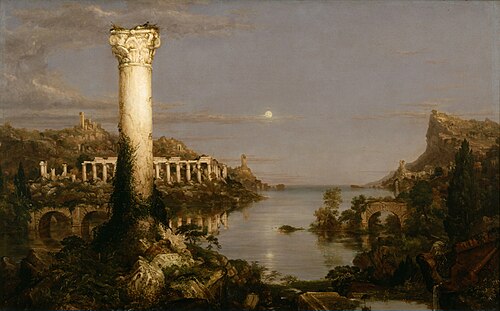
|
|
Desolation is the fifth in a series of five oil-on-canvas paintings entitled The Course of Empire, created by the American artist Thomas Cole between 1833 and 1836. The series, now in the collection of the New-York Historical Society, depicts the growth and fall of an imaginary city, situated at the lower end of a river valley. In this painting, the remains of the city are depicted decades after its destruction by invaders, with the landscape beginning to return to wilderness. Painting credit: Thomas Cole
Recently featured:
|
June 2

|
The white-plumed honeyeater (Ptilotula penicillata) is a species of small passerine bird endemic to Australia. The species is common around water, and they are often seen in backyards and suburbs with vegetation cover. First described by the English naturalist John Gould in 1837, the specimen he examined came from the "interior of New South Wales". The specific epithet penicillata derives from the Latin word penicillis, meaning 'brush tip', referring to the white plume across the side of the neck, its distinguishing characteristic. The rest of the bird is mainly olive-coloured. This white-plumed honeyeater was photographed in Glen Davis, New South Wales. Photograph credit: John Harrison
Recently featured:
|
June 3

|
The crankset (also known as a chainset in the UK) of a bicycle is the component of the drivetrain that converts the reciprocating motion of the rider's legs into rotational motion used to drive the chain or belt, which in turn drives the rear wheel. The road-bicycle crankset depicted in this photograph was manufactured by Shimano, with two chainrings and 172.5 mm (6.79 in) cranks. Photograph credit: Petar Milošević
Recently featured:
|
June 4

|
The Counting of the Omer is a commandment in Judaism of counting the days that pass between Pesach (Passover) and Shavuot (the Feast of Weeks). This mitzvah (commandment) derives from a commandment in the Torah to count 49 days beginning from the day on which the Omer, a sacrifice containing an omer-measure of barley, was offered in the Temple in Jerusalem, up until the day before an offering of wheat was brought to the Temple on Shavuot. The Counting of the Omer begins on the second day of Passover (the 16th day of Nisan) for Rabbinic Jews (Orthodox, Conservative, Reform), and after the weekly Shabbat during Passover for Karaite Jews, and ends the day before the holiday of Shavuot, which is the 'fiftieth day'. This image depicts an Omer calendar for 1904 produced by Baruch Zvi Ring with ink, paint, pencil, and watercolor on cut-out paper. It is in the collection of the Jewish Museum in New York. Artwork credit: Baruch Zvi Ring
Recently featured:
|
June 5
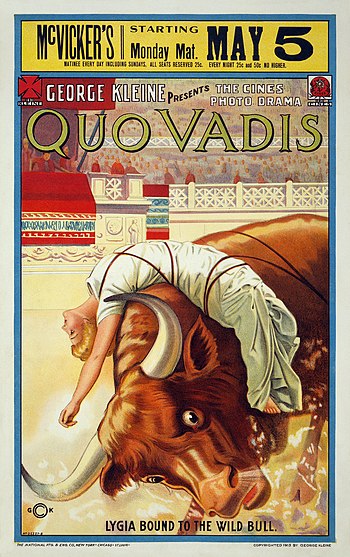
|
Quo Vadis is a 1913 Italian silent film directed by Enrico Guazzoni for Cines, based on a novel of the same name by Henryk Sienkiewicz. It was one of the first blockbusters in the history of cinema, with five thousand extras, lavish sets, and a lengthy running time of two hours. Set during the latter years of the reign of the Roman emperor Nero, the film depicts his persecution of Christians in the Roman Empire in the mid–1st century. This poster, produced for the American film producer George Kleine to advertise Quo Vadis, depicts the execution of Lygia, a young Christian woman, in the Circus of Nero in Rome: she is tied to the back of a bull, in imitation of the mythological princess Europa. Poster credit: The National Printing and Engraving Company; restored by Adam Cuerden
Recently featured:
|
June 6

|
|
The Monument to Alfonso XII is located in Buen Retiro Park (El Retiro) in Madrid, Spain. Measuring 30 m (98 ft) high, 86 m (282 ft) long, and 58 m (190 ft) wide, it has at its center an equestrian statue of King Alfonso XII, cast in bronze by the Spanish sculptor Mariano Benlliure in 1904. The monument is situated on the eastern edge of an artificial lake near the center of the park and was inaugurated on 6 June 1922. Architecture credit: José Grases Riera; photographed by Carlos Delgado
Recently featured:
|
June 7

|
Paratroopers at the Western Wall is a photograph taken on 7 June 1967 by the Israeli photographer and photojournalist David Rubinger. Shot from a low angle, the photograph depicts three Israeli paratroopers framed against the Western Wall in the Old City of Jerusalem, shortly after its capture from Arab forces in the Six-Day War. From left to right, the soldiers are Zion Karasenti, Yitzhak Yifat, and Haim Oshri, reservists of the 66th Battalion, 55th Paratroopers Brigade. The image engenders such a strong emotional component that it has become an icon of Israel. Mishael Cheshin, a justice of the Supreme Court of Israel, said in 2001 that the photograph had "become the property of the entire nation". Photograph credit: David Rubinger
Recently featured:
|
June 8
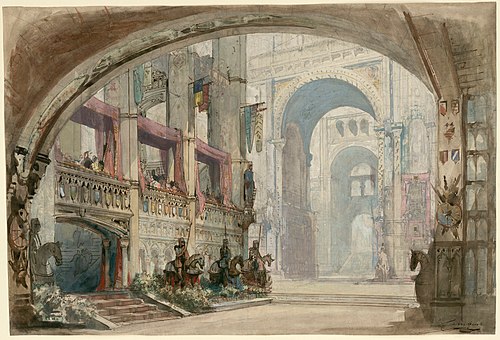
|
|
Robert Bruce is an 1846 pastiche opera in three acts, with music by Gioachino Rossini and Louis Niedermeyer to a French-language libretto by Alphonse Royer and Gustave Vaëz, after Sir Walter Scott's History of Scotland. The music was stitched together by Niedermeyer, with the composer's permission, with pieces from La donna del lago, Zelmira, and other Rossini operas. The work was premiered on 30 December 1846 by the Paris Opera at the Salle Le Peletier. This illustration is the set for act 3 of the opera, taking place in the ramparts of Stirling Castle, designed by Charles-Antoine Cambon. Set design credit: Charles-Antoine Cambon; restored by Adam Cuerden
Recently featured:
|
June 9

|
The Anatomy Lesson of Dr. Nicolaes Tulp is a 1632 oil-on-canvas painting by Rembrandt housed in the Mauritshuis museum in The Hague, Netherlands. The painting is regarded as one of Rembrandt's early masterpieces. In the work, Nicolaes Tulp is pictured explaining the musculature of the arm to a group of doctors. Some of the spectators are various doctors who paid to be included in the painting. The painting is signed in the top-left hand corner Rembrandt. f[ecit] 1632. This may be the first instance of Rembrandt signing a painting with his forename (in its original form) as opposed to the monogram RHL ("Rembrandt Harmenszoon of Leiden"), and is thus a sign of his growing artistic confidence. Painting credit: Rembrandt
Recently featured:
|
June 10
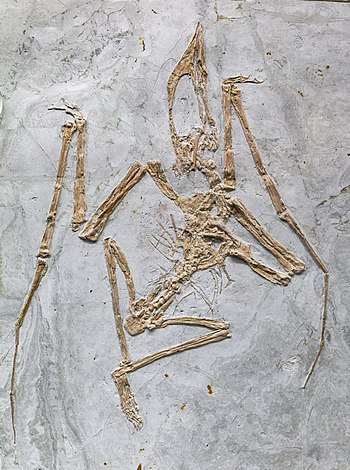
|
Sinopterus dongi was a species of pterosaur that lived in the Early Cretaceous, about 120 million years ago. Like all the other members of the family Tapejaridae, Sinopterus is known for its large skull, which has a prominent crest and a birdlike pointed beak, and its lack of teeth. It was also a member of the Jehol Biota, an Early Cretaceous ecosystem mainly found in Liaoning, China best known for its feathered dinosaurs that has a crucial impact on studying the relationship between dinosaurs and birds. This S. dongi fossil specimen was collected in Chaoyang, in the western part of Liaoning. Part of the collection of the Beijing Museum of Natural History, the fossil was temporarily exhibited at the National Museum of Natural Science in Taichung, Taiwan. Photograph credit: Y.-C. Tsai
Recently featured:
|
June 11

|
Julia Margaret Cameron (11 June 1815 – 26 January 1879) was a British photographer who is considered to be one of the most important portraitists of the 19th century. She is known for her soft-focus close-ups of famous Victorian men and for illustrative images depicting characters from mythology, Christianity and literature. Cameron also produced sensitive portraits of women and children. After showing a keen interest in photography for many years, she took up the practice at the relatively late age of 48, when her daughter gave her a camera as a present. She quickly produced a large body of work capturing the genius, beauty, and innocence of the men, women, and children who visited her studio, and created unique allegorical images inspired by tableaux vivants, theatre, 15th-century Italian painters, and the work of her creative contemporaries. Her photography career was short but productive; she made around 900 photographs over a twelve-year period. This portrait of Cameron, in the collection of the Metropolitan Museum of Art in New York, was taken in 1870 by her son Henry Herschel Hay Cameron. Photograph credit: Henry Herschel Hay Cameron; restored by Adam Cuerden
Recently featured:
|
June 12
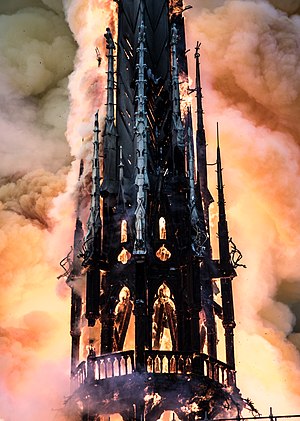
|
The Notre-Dame fire broke out in the cathedral of Notre-Dame de Paris on 15 April 2019, causing severe damage to the building's spire, roof, and upper walls. The fire resulted in the contamination of the site and nearby areas of the city with toxic dust and lead. Investigators believed that the fire was caused by a cigarette or an electrical short circuit; the prosecutor of Paris found no evidence showing the fire was started deliberately. The cathedral's wooden spire, or flèche, was built by Eugène Viollet-le-Duc in the Gothic Revival style and installed in 1859, weighing around 250 tons. This photograph, taken during the 2019 fire, depicts the spire of Notre-Dame aflame; it collapsed shortly afterwards. Photograph credit: Guillaume Levrier
Recently featured:
|
June 13
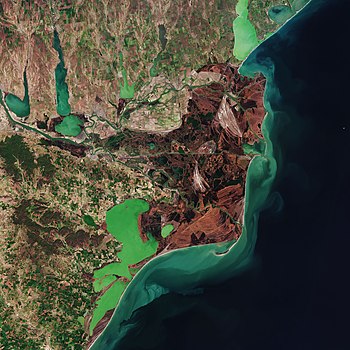
|
The Danube Delta is the second-largest river delta in Europe, after the Volga Delta, and the best preserved on the continent. While a small part of the delta lies in Ukraine (Odesa Oblast), a majority of its area of 3,446 km2 (1,331 sq mi) lies in Romania (Tulcea County). With the lagoons of Razim–Sinoe, located south of the main delta, the combined territory of 5,165 km2 (1,994 sq mi) is designated a World Heritage Site. Photograph credit: European Space Agency
Recently featured:
|
June 14
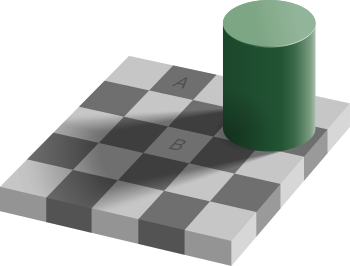
|
The checker shadow illusion is an optical illusion published in 1995 by Edward Adelson, an American professor of vision science at the Massachusetts Institute of Technology. The phenomenon features an image of a checkerboard with light and dark squares, partly shadowed by another object, such as a cylinder as in this illustration. The optical illusion is that the area labeled A appears to be darker than the area labeled B. However, within the context of the two-dimensional image, they are of identical brightness – in other words, they would be printed with identical mixtures of ink, or displayed on a screen with pixels of identical color. Optical illusion credit: Edward Adelson; illustrated by Pbrks
Recently featured:
|
June 15
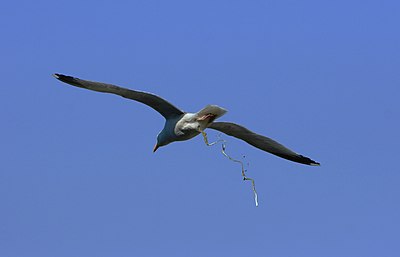
|
Guano is the accumulated excrement of seabirds and bats. As a manure, guano is a highly effective fertilizer due to its exceptionally high content of nitrogen, phosphate, and potassium: key nutrients essential for plant growth. Guano was also, to a lesser extent, sought for the production of gunpowder and other explosive materials. The demand for guano in the 19th century spurred the human colonization of remote bird islands in many parts of the world, resulting in some of the first examples of United States colonialism and the expansion of the British Empire. However, the guano-mining process resulted in ecological degradation through the loss of millions of seabirds. This photograph, taken near Île-de-Bréhat in northwestern France, depicts a herring gull (Larus argentatus) excreting waste, which accumulates to form guano. Photograph credit: Nicolas Sanchez
Recently featured:
|
June 16

|
An odd-eyed cat is a cat with one blue eye and one eye either green, yellow, or brown. This is a feline form of complete heterochromia, a condition that occurs in some other animals, including humans. There is also partial heterochromia, where there can be one blue eye and one eye that is partially blue and partially another color. The condition most commonly affects white cats, but may be found in a cat of any color, provided that it possesses the white-spotting gene. This white domestic cat has complete heterochromia, with a blue left eye and a yellow right eye. Photograph credit: Keith Kissel
Recently featured:
|
June 17
|
Bolungarvík is a small town and the only built-up area in the municipality of Bolungarvíkurkaupstaður in the northwest of Iceland, located on the peninsula of the Westfjords, approximately 14 kilometres (8.7 miles) from the town of Ísafjörður and 473 kilometres (294 miles) from the capital city Reykjavík. The town is near abundant fishing grounds and has been used as an outpost for fishing since the 17th century, making it one of the earliest in Iceland. Bolungarvík was not accessible by road until 1950, and in 2010 a tunnel was opened under the mountain to bypass the old road, which was frequently subject to avalanches and rock falls. This panoramic photograph of Bolungarvík was taken in early July 2018 from the avalanche dam that overlooks the town. Lupin, which covers much of this area of Iceland in summer, is visible at the extreme bottom left of the image. Photograph credit: Veggies
Recently featured:
|
June 18
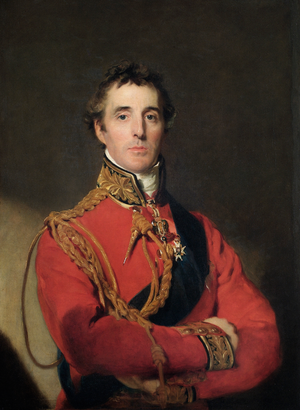
|
Arthur Wellesley, 1st Duke of Wellington (1769–1852) was an Anglo-Irish soldier and Tory statesman who was one of the leading military and political figures of 19th-century Britain, serving twice as prime minister. He is one of the commanders who won and ended the Napoleonic Wars when a coalition of European powers defeated Napoleon at the Battle of Waterloo on 18 June 1815. This oil-on-canvas portrait, painted by Sir Thomas Lawrence shortly after the Battle of Waterloo, depicts Wellington wearing the uniform of a field marshal with the insignia of the Order of the Garter and the Order of the Golden Fleece. The painting is part of the collection of Apsley House, the London townhouse of the Dukes of Wellington. Painting credit: Thomas Lawrence; image restored by Hohum
Recently featured:
|
June 19

|
The Hunting of the Snark is a nonsense poem by the English writer Lewis Carroll, telling the story of ten characters who cross the ocean to hunt a mysterious creature known as the Snark. The poem was published in 1876 with illustrations by Henry Holiday. This is the sixth plate from Holiday's illustrations, depicting the search for the snark planned in "Fit the Fourth" and commencing in "Fit the Fifth": They sought it with thimbles, they sought it with care; Illustration credit: Henry Holiday; restored by Adam Cuerden
Recently featured:
|
June 20
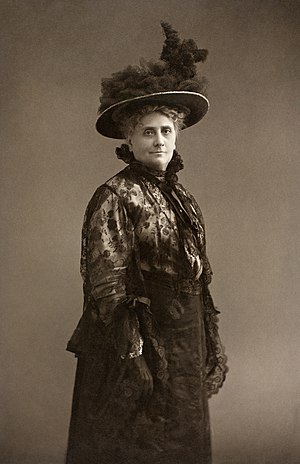
|
Gina Krog (20 June 1847 – 14 April 1916) was a Norwegian suffragist, teacher, liberal politician, writer and editor. She played a central role in the Norwegian women's movement from the 1880s until her death, notably as a leading campaigner for women's right to vote. In 1884, Krog co-founded the Norwegian Association for Women's Rights with liberal MP Hagbart Berner. Over the next two decades, Krog co-founded the Women's Voting Association, the National Association for Women's Suffrage, and the Norwegian National Women's Council, spearheading the presentation of women's suffrage proposals to the Storting (the Norwegian parliament). She was an early member of the Liberal Party and served as a deputy member of its national board. Krog was regarded as an unapologetic liberal progressive during her time, seeking full and equal voting rights for all women on the same conditions as men, which was achieved in 1913. She was the first woman in Norway to receive a state funeral. Photograph credit: Eivind Enger; restored by Adam Cuerden
Recently featured:
|
June 21
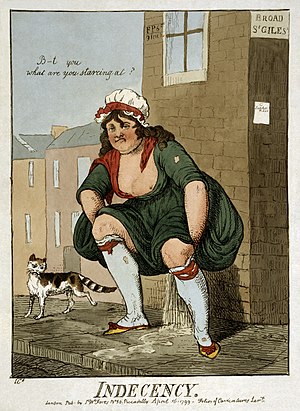
|
Isaac Cruikshank (1764–1811) was a Scottish painter and caricaturist. He was born in Edinburgh and spent most of his career in London. Cruikshank is known for his social and political satire. His first known publications were etchings of Edinburgh "types", from 1784. He produced illustrations for books about the theatre, did the frontispiece for Witticisms and Jests of Dr Johnson (1791), and illustrated George Shaw's extensive General Zoology (1800–1826). With James Gillray, Cruikshank developed the figure of John Bull, the nationalistic representation of a solid British yeoman. He died of alcohol poisoning at the age of fifty-five as a result of a drinking contest, of which he was declared the winner. This 1799 illustration by Cruikshank, titled "Indecency", depicts a woman urinating in the street and saying: "B[las]t you what are you stareing [sic] at?" Engraving credit: Isaac Cruikshank; restored by Lise Broer
Recently featured:
|
June 22
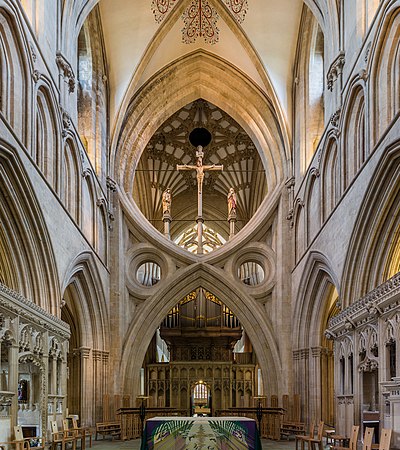
|
Wells Cathedral is an Anglican cathedral in Wells, Somerset, commenced around 1175 on the site of a late-Roman mausoleum and an 8th-century abbey church. The cathedral has been described by the architectural historian John Harvey as Europe's first truly Gothic structure, lacking the Romanesque work that survives in many other cathedrals. It is the seat of the bishop of Bath and Wells. This photograph depicts the St Andrew's Cross arches under the tower, viewed from the nave. Photograph credit: David Iliff
Recently featured:
|
June 23

|
Théophile Thoré-Bürger (23 June 1807 – 30 April 1869) was a French journalist and art critic. He is best known today for his rediscovery of the work of painter Johannes Vermeer and several other prominent Dutch artists, such as Frans Hals. This portrait photograph of Thoré-Bürger was taken by the French photographer Nadar. Photograph credit: Nadar; restored by Adam Cuerden
Recently featured:
|
June 24
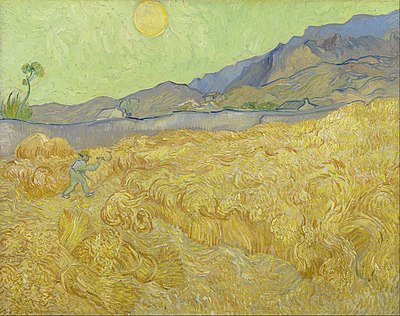
|
Reaper is a series of three oil-on-canvas paintings by the Dutch artist Vincent van Gogh of a man reaping a wheat field under a bright early-morning sun. This is the second painting in the series, which Van Gogh appears to have completed in a single day in Saint-Rémy-de-Provence, France, while taking breaks to write a letter on 4–5 September 1889. In a later part of the letter, he announced: "Phew – the reaper is finished, I think it will be one that you'll place in your home". Van Gogh initially preferred this version over the earlier study, describing it as "an image of death as the great Book of Nature speaks to us about it – but what I sought is the 'almost smiling'. It's all yellow except for a line of violet hills – a pale, blond yellow. I myself find that funny, that I saw it like that through the iron bars of a cell." The painting is now in the collection of the Van Gogh Museum in Amsterdam. Painting credit: Vincent van Gogh
Recently featured:
|
June 25

|
Crystal Eastman (June 25, 1881 – July 28, 1928) was an American lawyer, antimilitarist, feminist, socialist, and journalist. She is best remembered as a leader in the fight for women's suffrage, as a co-founder and co-editor with her brother Max Eastman of the radical arts and politics magazine The Liberator, co-founder of the Women's International League for Peace and Freedom, and co-founder in 1920 of the American Civil Liberties Union. In 2000, she was inducted into the National Women's Hall of Fame in Seneca Falls, New York. Photograph credit: Edmonston, Washington, D.C.; restored by Adam Cuerden
Recently featured:
|
June 26

|
The diamond firetail (Stagonopleura guttata) is a species of estrildid finch that is endemic to Australia. To safeguard their eggs and nestlings, they are often recorded building their nests into the base of the large stick-nest of a bird of prey, such as a whistling kite, white-bellied sea eagle, wedge-tailed eagle, brown falcon, nankeen kestrel, or square-tailed kite; one recorded nest of a whistling kite contained nine diamond firetail nests within. This diamond firetail was photographed in Glen Alice, New South Wales. Photograph credit: John Harrison
Recently featured:
|
June 27
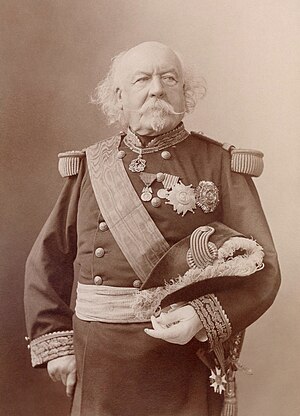
|
François Certain de Canrobert (27 June 1809 – 28 January 1895) was a French general who held the title of Marshal of France. A staunch supporter of Emperor Napoleon III, he became one of the leading figures in the Bonapartist party under the French Third Republic. This photograph of Canrobert in military uniform was taken by the French photographer Nadar. Photograph credit: Nadar; restored by Adam Cuerden
Recently featured:
|
June 28
Silver certificates are a type of representative money issued between 1878 and 1964 in the United States as part of its circulation of paper currency. They were produced in response to silver agitation by citizens who were angered by the Coinage Act of 1873, which had effectively placed the United States on a gold standard. Since 1968 they have been redeemable only in Federal Reserve Notes and are thus obsolete, but they remain legal tender at their face value and hence are still an accepted form of currency. This is a complete set of the 1891 series of large-size silver certificates, designed by the Bureau of Engraving and Printing and comprising eight denominations from $1 to $1000. Each banknote bears the signatures of James Fount Tillman (Register of the Treasury) and Daniel N. Morgan (Treasurer of the United States), and a portrait of a different individual, identified above. Banknote design credit: Bureau of Engraving and Printing; photographed by Andrew Shiva
Recently featured:
|
June 29

|
The Church of St. Peter and St. Paul is a Roman Catholic church located in the neighbourhood of Antakalnis in Vilnius, Lithuania. Its interior has masterful compositions of some two thousand stucco figures by Pietro Perti and ornamentation by Giovanni Maria Galli da Bibiena, and is unique in Europe. The church is dedicated to Saint Peter and Saint Paul, whose feast day is celebrated on 29 June. This photograph of the interior depicts the church's chancel with the main altar. The large central painting by Franciszek Smuglewicz depicts the emotional final parting of Peter and Paul. A life-sized sculpture of Jesus, known as Jesus of Antakalnis, is visible in a niche on the left of the image. Photograph credit: David Iliff
Recently featured:
|
June 30

|
|
Ignace-Gaston Pardies (1636–1673) was a French Catholic priest and scientist. His celestial atlas, entitled Globi coelestis in tabulas planas redacti descriptio, comprised six charts of the night sky and was first published in 1674. The atlas uses a gnomonic projection so that the plates make up a cube of the celestial sphere. The constellation figures are drawn from Uranometria, but were carefully reworked and adapted to a broader view of the sky. This is the fourth plate from a 1693 edition of Pardies's atlas, featuring constellations including Virgo, Libra and Boötes, visible in the northern sky. Map credit: Ignace-Gaston Pardies |
Picture of the day archives and future dates





